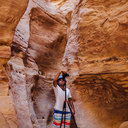2 Likes
Wikipedia: "Stokkseyri, a small town in Southern Iceland, with a population of around 445 inhabitants.Founded around 900 AD by the settler Hásteinn Atlason. It was an important fishing and trading village in previous times, and now it's become more of a tourist attraction. The town is founded on the Great Þjórsá lava.
The Great Þjórsá Lava is the largest lava flow in Iceland both according to area and volume and the largest lava that is known to have erupted in a single eruption in the Holocene time. It belongs to a group of lavas known as the Tungná lavas. It was erupted in the Veiðivötn region, Central Iceland, 8600 years BP (6600 BC). The crater area is covered by younger lavas and eruptives. The Þjórsá lava does not appear on the surface until 70 km downstream of its supposed crater area. In the lowlands the lava has overflown wide areas, covering the districts Landsveit, Gnúpverjahreppur, Skeið and Flói. The main rivers of S-Iceland Þjórsá and Hvítá/Ölfusá stream along the borders of the lava in east and west and the 25 km (16 mi) long beach between the river mouths is formed by. Then the sea level seems to have been around 15 m (49 ft) lower than to day. Along with rising sea level the ocean has transgressed the lava front so its border line is submerged several hundreds of metres off-shore and an interesting littoral zone can be inspected along the beach. The towns of Selfoss, Eyrarbakki and Stokkseyri are built on the lava. Its area is around 970 km2 (370 sq mi), the thickness 26 m (85 ft) and volume therefore close to 26 km3 (6.2 cu mi). The Þjórsá lava is porphyritic with large light coloured feldspar phenocrysts sitting in a dark, fine grained ground mass."
...




